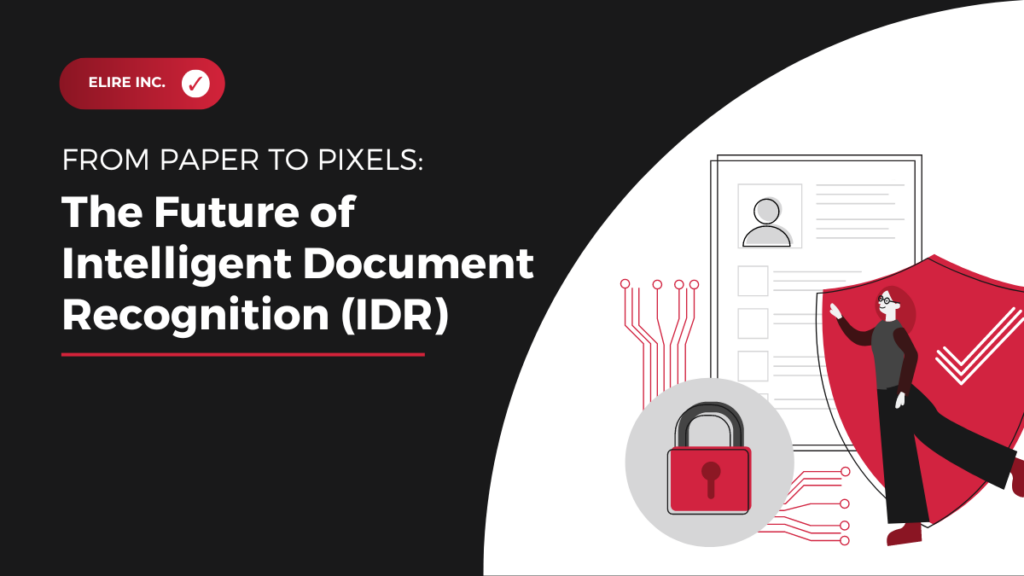
In Today’s digital era, organizations face challenges efficiently managing large volumes of documents, and in turn, extracting relevant data across various business processes. Oracle’s Intelligent Document Recognition (IDR) is a powerful automated solution that can save your organization countless man hours, reduce data extraction errors, and improve operational efficiency.
What is Intelligent Document Recognition?
Oracle Intelligent Document Recognition (IDR) is an advanced software solution designed to automate and streamline data extraction from documents, invoices, purchase orders, receipts, and forms. IDR utilizes artificial intelligence (AI) and machine learning (ML) to recognize and interpret document content. As IDR operates machine learning, it learns from its mistakes, and allows users to train it to catch specific information on different suppliers’ invoices. Elire has successfully leveraged this updated ML feature on numerous occasions. Overall, this data extraction tool can accurately collect data points including dates, purchase amounts, and addresses in both structured and unstructured documents.
This automated data tool aids organizations in data entry, reduces the need for manual data input, and improves efficiency in document processing. IDR can successfully extract content from documents in many different formats, languages, and layouts, all while fulfilling different business requirements. By leveraging Oracle IDR, your corporation can streamline document data management, enhance data accuracy, and improve operational productivity. For a more in-depth overview of Oracle Intelligent Document Recognition (IDR), take a look at the “Oracle Intelligent Document Recognition Highlights” in Elire’s Cloud ERP Industry Insights.
Current Uses for Intelligent Document Recognition
Oracle’s Intelligent Document Recognition harnesses the power of AI and ML to efficiently manage document workflows and data extraction processes. IDR’s transformative data extraction capabilities are utilized across many different industries and business operations. Here are just a few examples of how Oracle’s IDR can improve business functions:
- Invoice Processing: One of the primary applications of Oracle IDR is automating invoice processing by intelligently extracting key details from various documents. IDR pulls vendor information, invoice numbers, line items, and totals, to create an automated invoice and streamline the accounts payable process. To dive deeper into IDR Invoice capabilities, check out Oracle’s “Implementing Payables Invoice to Pay” overview.
- Purchase Order Processing: Oracle IDR facilitates extraction of critical data from purchase orders. IDR captures and interprets vendor information, purchase order numbers, item information, and purchase quantities.
- Document Classification and Routing: The IDR system categorizes incoming documents based on predefined guidelines, and promptly delivers identified documents to the correct department.
The streamlining of these business functions is greatly due to IDR’s machine learning abilities that correctly identify and classify relevant information from documents. Currently, Intelligent Document Recognition operates aspects of Oracle’s Optical Character Recognition (OCR) and other pattern recognition techniques to better analyze and understand data points. Although IDR utilizes aspects of Oracle’s OCR, these software systems operate in different manners and meet different needs. To learn more about the differences between Intelligent Document Recognition (IDR) and Optical Character Recognition (OCR), view Elire’s “IDR vs OCR” blog post.
The Future of Intelligent Document Recognition
Looking to the future, there are countless possibilities for IDR to evolve and expand. One potential area for advancement is data extraction and interpretation. IDR can further improve its ability to accurately extract and interpret data from a wide range of documents by incorporating more advanced natural language processing (NLP) algorithms and machine learning techniques. By advancing IDR’s NLP and ML capabilities, the data extraction system can handle more complex document structures, diverse data formats, and multiple languages.
Additionally, IDR has the potential to provide greater data insights by analyzing patterns, trends, and anomalies within documents. By generating more actionable intelligence, IDR can better contribute to organizations decision making processes and help users identify areas of improvement. This elevation in understanding will allow organizations to gain deeper meaning and strategic value from recognized documents.
Lastly, IDR has the possibility to incorporate more industry-specific knowledge and customizable extraction rules. This system update would optimize IDR’s accuracy and efficiency in business sectors such as healthcare, finance, legal, and logistics. Working in-tandem with industry-specific capabilities, IDR may one day work collaboratively with other workflow management systems. This cross-platform collaboration would mean more efficient document sharing, version control, and tracking of document related tasks. This integration could lead to streamlined data sharing, enhanced document traceability, and improve overall productivity.
What’s Next?
The future of Oracle Intelligent Document Recognition (IDR) is filled with tremendous potential. Through advancements in data extraction, integration with emerging technologies, and adoption of industry-specific capabilities, IDR has the opportunity to revolutionize document management processes. As your organization looks to optimize data extraction and streamline document processes, look to IDR for new and evolving solutions. Oracle’s Intelligent Document Recognition can help your business improve productivity, reduce data errors, and streamline your data extraction process.
To learn more about Oracle’s Intelligent Document Recognition tool or other Oracle Cloud services, subscribe to the Elire Monthly Cloud Newsletter or check out our Cloud Services page. If you have any questions regarding Oracle Cloud technology or would like to speak with an Elire Expert, please reach out to [email protected].
Just starting your Cloud journey? Don’t worry, we’ve got you covered there too. Take a look at Elire’s Path to Cloud webpage for next steps in your PeopleSoft to Cloud journey. In the meantime, follow Elire on LinkedIn and Twitter to receive Oracle Cloud updates directly to your phone.
Author
-

Ms. Hutchcraft serves as Elire’s Marketing Specialist, working to develop and optimize marketing brand assets. Jordan collaborates with the Elire Team to produce blog and social media content, strategize for social media expansion, and maintain Elire’s internal and external branding.
View all posts
